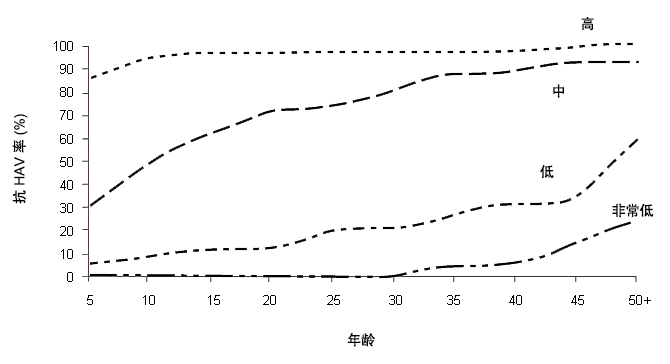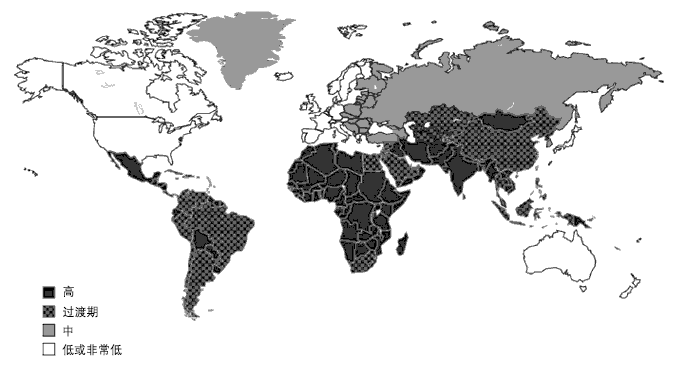根据甲肝抗体在特定年龄组的检出率,可以将全球甲型肝炎感染划分为四个主要区域。即高、中、低或极低地方流行/发病区。患病率高的地区通常卫生设施或卫生条件较差,包括非洲和亚洲、拉丁美洲的部分地区。在这些地区,大多数甲型肝炎感染发生在儿童早期。在儿童中,感染多无症状,因此,报告的发病率会偏低。在甲型肝炎的高发地区,成年人一般都具有免疫力。在发展中国家,如欧洲的南部和东部以及中东部分地区,因其卫生条件差异较大,发病率趋于中等。而这部分地区实际报告的发病率较高,是由于出现伴有症状的老年感染者群体。低发区包括西欧、澳大利亚和美国,而发病率极低的区域,包括北欧和日本。在低发区,儿童时期感染率较低,而大多数人整个成年期均易感。[6]World Health Organization. Hepatitis A. 2000. http://www.who.int/ (last accessed 27 March 2017).http://www.who.int/csr/resources/publications/hepatitis/WHO_CDS_CSR_EDC_2000_7/en/[7]Hodges M, Sanders E, Aitken C. Seroprevalence of hepatitis markers; HAV, HBV, HCV and HEV amongst primary school children in Freetown, Sierra Leone. West Afr J Med. 1998;17:36-37.http://www.ncbi.nlm.nih.gov/pubmed/9643158?tool=bestpractice.com[8]Sawayama Y, Hayashi J, Ariyama I, et al. A ten year serological survey of hepatitis A, B, and C viruses infections in Nepal. J Epidemiol. 1999;9:350-354.http://www.ncbi.nlm.nih.gov/pubmed/10616269?tool=bestpractice.com[9]Hau CH, Hien TT, Tien NT, et al. Prevalence of enteric hepatitis A and E viruses in the Mekong River delta region of Vietnam. Am J Trop Med Hyg. 1999;60:277-280.http://www.ncbi.nlm.nih.gov/pubmed/10072151?tool=bestpractice.com[10]Arankalle VA, Tsarev SA, Chadha MS, et al. Age-specific prevalence of antibodies to hepatitis A and E viruses in Pune, India, 1982 and 1992. J Infect Dis. 1995;171:447-450.http://www.ncbi.nlm.nih.gov/pubmed/7844387?tool=bestpractice.com[11]Beran J, Douda P, Rychly R. Seroprevalence of viral hepatitis in the Czech Republic. Eur J Epidemiol. 1999;15:805-808.http://www.ncbi.nlm.nih.gov/pubmed/10608359?tool=bestpractice.com[12]Beutels M, Van Damme P, Aelvoet W, et al. Prevalence of hepatitis A, B and C in the Flemish population. Eur J Epidemiol. 1997;13:275-280.http://www.ncbi.nlm.nih.gov/pubmed/9258525?tool=bestpractice.com [Figure caption and citation for the preceding image starts]: 全球甲型肝炎病毒感染状况疾病预防控制中心网站;经许可使用 [Citation ends].
[Figure caption and citation for the preceding image starts]: 全球甲型肝炎病毒感染状况疾病预防控制中心网站;经许可使用 [Citation ends]. [Figure caption and citation for the preceding image starts]: 甲型肝炎流行的地理分布(根据现有数据汇总)疾病预防控制中心网站;经许可使用 [Citation ends].
[Figure caption and citation for the preceding image starts]: 甲型肝炎流行的地理分布(根据现有数据汇总)疾病预防控制中心网站;经许可使用 [Citation ends].
在美国,在可以通过疫苗接种预防的疾病中,甲肝是最常见报道的疾病之一。1997年,报告的感染病例超过30 000例,推测实际发病人数约90 000例。[13]Centers for Disease Control and Prevention. Prevention of hepatitis A through active or passive immunization: recommendations of the Advisory Committee on Immunization Practices (ACIP). MMWR Recomm Rep. 1999;48:1-37.http://www.cdc.gov/MMWR/preview/mmwrhtml/rr4812a1.htmhttp://www.ncbi.nlm.nih.gov/pubmed/10543657?tool=bestpractice.com催化模型显示,1980-1999年期间,每年估计有270 000人发生甲型肝炎病毒感染。[14]Armstrong GL, Bell BP. Hepatitis A virus infections in the United States: model-based estimates and implications for childhood immunization. Pediatrics. 2002;109:839-845.http://www.ncbi.nlm.nih.gov/pubmed/11986444?tool=bestpractice.com而自1996年以来,在高危人群中广泛接种甲型肝炎灭活疫苗对美国甲型肝炎发病率的下降是有帮助的。[15]Wasley A, Samandari T, Bell BP. Incidence of hepatitis A in the United States in the era of vaccination. JAMA. 2005;294:194-201.http://www.ncbi.nlm.nih.gov/pubmed/16014593?tool=bestpractice.com2007年,甲型肝炎发病率为1/100 000,这是有史以来甲肝发病率的最低记录。[16]Daniels D, Grytdal S, Wasley A; Centers for Disease Control and Prevention (CDC). Surveillance for acute viral hepatitis: United States, 2007. MMWR Surveill Summ. 2009;58:1-27.http://www.cdc.gov/mmwr/preview/mmwrhtml/ss5803a1.htmhttp://www.ncbi.nlm.nih.gov/pubmed/19478727?tool=bestpractice.com在宣布对儿童进行常规疫苗接种的州,发病率下降最显著。
甲型肝炎的全球流行病学也在不断变化,随着生活条件的改善,发展中国家的儿童感染人数下降。结果,成年人病例的比例相对有所增加,因为由于存在一个缺少保护性抗体的更大的成年人群体。
 [Figure caption and citation for the preceding image starts]: 全球甲型肝炎病毒感染状况疾病预防控制中心网站;经许可使用 [Citation ends].
[Figure caption and citation for the preceding image starts]: 全球甲型肝炎病毒感染状况疾病预防控制中心网站;经许可使用 [Citation ends]. [Figure caption and citation for the preceding image starts]: 甲型肝炎流行的地理分布(根据现有数据汇总)疾病预防控制中心网站;经许可使用 [Citation ends].
[Figure caption and citation for the preceding image starts]: 甲型肝炎流行的地理分布(根据现有数据汇总)疾病预防控制中心网站;经许可使用 [Citation ends].